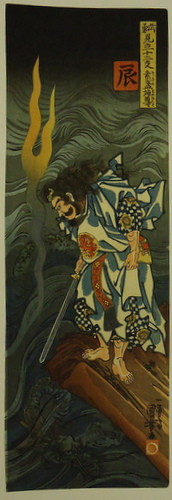Utagawa Kuniyoshi

Utagawa Kuniyoshi was an Utagawa school ukiyo-e artist of the early 19th century, known especially for his musha-e, depictions of famous historical or legendary warriors.
Kuniyoshi's first prints were issued in 1814, but it wasn't until 1827 that he came into his own, gaining a popularity to come out from under the shadow of Utagawa Kunisada. In that year, he designed a series of 108 images of the heroes of the Suikoden, a Ming Dynasty novel republished in a Japanese version by Takizawa Bakin beginning in 1805.[1]
Kuniyoshi got in trouble with the authorities in 1843, when they accused that his print depicting Minamoto no Raikô and the Earth Spider, a traditional theme, was a veiled reference to the current Shogun, Tokugawa Ieyoshi, and his controversial chief minister Mizuno Tadakuni. The authorities alleged that Raikô himself represented the shogun, the Shitennô (Four Deva Kings) the chief ministers, and the demon hordes the peasantry rioting against the shogunate's draconian policies and harsh taxes. Some accounts indicate that Kuniyoshi escaped the incident without punishment, while others suggest that the woodblocks used to make that set of prints were destroyed, and that Kuniyoshi was forced to pay a fine.[2]